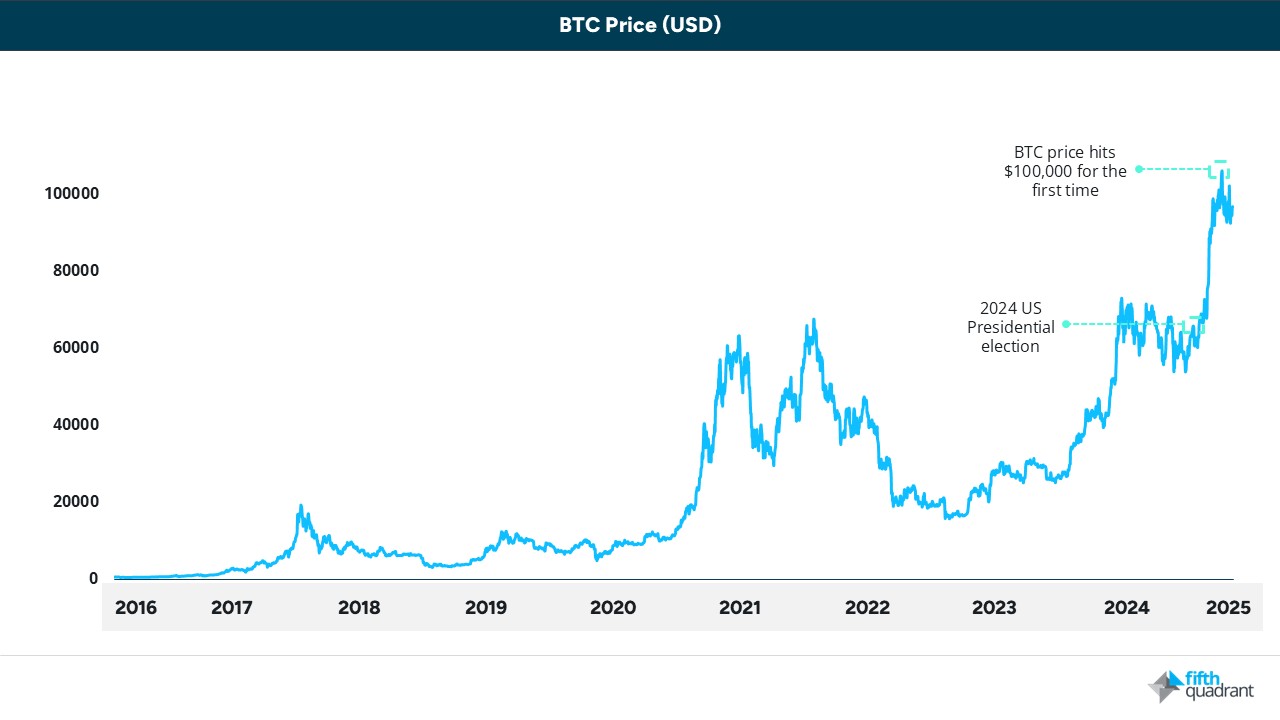Author: Angus McLachlan | Posted On: 01 Jan 2025
As we enter 2025, the global landscape continues to evolve at a rapid pace, shaped by technological breakthroughs, financial transformations, and environmental challenges. This analysis examines key global trends from 2024 and offers predictions for the year ahead, focusing on three critical areas that will significantly impact our future: artificial intelligence, cryptocurrency, and environmental sustainability.
AI global trends
2024 was a groundbreaking year for artificial intelligence, with significant advancements reshaping industries and expectations. The rise of AI agents, systems capable of autonomous thinking and action, marked a pivotal shift. Additionally, the deployment of AI in robotics and multimodal systems extended its reach beyond traditional devices, paving the way for smarter, more interactive environments.
Businesses that embraced AI saw remarkable gains, while for consumers, conversational AI has inspired a migration away from traditional search engines.
The year also witnessed the initial stages of stricter global AI regulations, focusing on transparency, ethical use, and accountability. As we found in The Australian Responsible AI Index 2024, transparency and accountability are key areas for improvement. Only 25% of organisations have engaged business leadership on responsible AI issues, and just 23% have implemented specific oversight and control measures. Hence, the need for a culture of transparency around AI ethics emerged as a key trend.
Predictions
2025 is set to be even more revolutionary for AI, driven by several key trends and predictions:
- AI Agents’ Dominance: The continued evolution of agentic AI will transform workflows by anticipating needs, automating complex processes, in turn boosting productivity substantially.
- Integration with Robotics: AI will increasingly interact with the physical world through robotics, wearables, and smart devices, tackling challenges in logistics, manufacturing, healthcare, and retail.
- Rising Costs: As adoption grows, operational expenses will climb, driven by higher token usage and the premium pricing of advanced models. Businesses may have to allocate larger budgets to remain competitive.
- Competitive Advantage: Companies that effectively integrate AI will see unparalleled efficiency and cost-saving opportunities, potentially outpacing competitors who lag in adoption. Conversely, failure to embrace AI could lead to obsolescence.
- Regulation: Global AI regulations are expected to tighten, emphasising accountability and ethical standards. In particular, the rise of ‘Deepfakes’ and purposely misleading AI-generated content remains a key challenge.
bitcoin
Bitcoin’s performance in 2024 was transformative, surpassing $100,000 for the first time, surging 40% following the US Presidential election. The U.S. SEC’s approval of spot Bitcoin ETFs injected billions in new liquidity and further legitimised Bitcoin as a mainstream investment. Major institutions like BlackRock and BNY Mellon embraced Bitcoin, stabilising its price and boosting its appeal as a long-term asset.

predictions
Entering 2025, Bitcoin’s momentum is driven by regulatory clarity, technological advancements like the Lightning Network, and increasing adoption by corporations integrating Bitcoin into their treasuries. Despite potential challenges, such as resistance from Central Bank Digital Currencies (CBDCs) and concerns over quantum computing, Bitcoin’s long-term outlook remains optimistic.
Bullish projections suggest prices could reach $250,000, fueled by institutional adoption and Bitcoin-backed financial products. Favourable global liquidity conditions and the shift toward bitcoin-friendly regulations – highlighted by supportive voices within the Trump administration – further support its growth. With reduced market supply due to long-term holdings and growing use in corporate finance, Bitcoin will further solidify its position in the global financial landscape.
environment & sustainability global trends
2024 was the hottest year on record, with the global average temperature reaching 1.55°C above the pre-industrial baseline – breaking the previous record set a year earlier. This is the first time the annual global average temperature has surpassed the critical 1.5°C threshold outlined in the 2015 Paris Climate Agreement.
The US alone experienced 183 billion dollars’ worth of weather and climate disasters in 2024. Meanwhile globally, 2024 saw an average of 41 more days of dangerous heat, and a surge in flooding events.
In response, renewables now account for approximately 40% of Australia’s total energy supply, alternate fuel-type new vehicle sales have seen continued growth, and consumers globally are showing an increased willingness to pay for green premiums.
However, significant challenges persist, including increasing power demand, potential rollbacks of climate initiatives in the US, and ongoing biodiversity loss and unmet conservation goals.
Predictions
- Solar Growth Slows: Solar energy installations are expected to increase by just 11% in 2025, down from 35% in 2024, as grid integration challenges arise due to higher solar contributions to national electricity mixes.
- Coal Resurgence: Despite progress in renewable energy, global coal consumption is projected to break records through 2027, driven by rising demand in nations like India and China, as well as a resurgence in coal reliance in the US due to increasing power demand.
- ESG Investment Shifts: The principles behind Environmental, Social, and Governance investing will continue to drive trillions of dollars into the energy transition, even as the ESG label faces political opposition, particularly in the US.
- Arctic Economic Race: The Arctic will become a focal point for economic and strategic interests, as warming temperatures unlock new sea routes and resource deposits, with countries like the US, China and Russia intensifying their involvement in the region. The Trump administration’s plan to make Greenland part of the US is a sign of things to come.
in summary
Looking ahead, 2025 promises to be a pivotal year of both opportunity and challenge. The acceleration of global trends of AI adoption will likely create a widening gap between organisations that embrace these technologies and those that don’t, while rising operational costs and stricter regulations will demand careful navigation. In the cryptocurrency space, Bitcoin’s institutional acceptance and favourable regulatory environment suggest continued growth, though the impact of emerging CBDCs remains to be seen. Crucially, environmental concerns have reached a critical juncture, with record-breaking temperatures and increased extreme weather events forcing a reassessment of our approach to sustainability. Despite global trends showing progress in renewable energy adoption, the projected increase in coal consumption and slowing solar growth present significant hurdles to achieving climate goals.
As these three domains increasingly intersect and influence each other, 2025 will require balanced, forward-thinking approaches to harness opportunities while addressing mounting challenges. Organisations and individuals alike must prepare for a year of transformation, adaptation, and strategic decision-making across these crucial areas.
Stay ahead of the curve by preparing for the transformative changes coming in 2025. Whether you’re a business leader, investor, or sustainability advocate, understanding these global trends is crucial for making informed decisions. Keep up to date with the latest research from Fifth Quadrant here. For any questions or inquiries, feel free to contact us here.
Posted in TL, Consumer & Retail, Energy Transition, Technology & Telco

